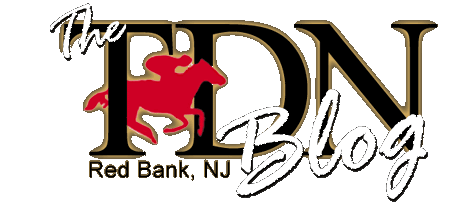Julian Brown is a Maryland horse owner who got his start back in 1994. I had known Julian as a talented horseplayer. Most of the horseplayers I knew would never become owners. Some owners I know became good handicappers only after owning horses. Julian's path to ownership seemed unconventional.
Julian's Black & Tan Stable is, he explains, "a play on the ethnic diversity of my family and also a tribute to the Duke Ellington Classic, Black and Tan Fantasy."
Mark: Tell me Julian, just how does a handicapper horseplayer like you end up owning horses?
 |
| Julian (right) winning a bike race |
Mark: I wonder if your handicapping skill has helped you in choosing horses to buy or claim.
Julian: I think my handicapping has helped me pick the right trainers and horses, but sometimes it has worked against me. For example, my handicapping research showed the effectiveness of 3 and 5 furlong works before races. When I asked my trainers to do so, it would conflict with the training methods that enabled them to have great statistics. That 3 furlong work may have an effect on the horse's physical condition that would prevent the horse from lasting very long. If my research showed that 2 weeks off was optimal for horses to return to the races, that research could conflict with the trainer's judgment that they are used to looking at a horse and know he is ready to run. Maybe a particular horse runs better once a month because of physical restrictions or dietary (or respiratory) reasons.
Mark: Any one aspect of handicapping that's a most effective bridge between playing the horses and owning them?
 |
| Julian (3rd from right) in the winner's circle. |
Mark: So then, why did you choose your trainer?
Julian: I chose Damon Dilodovico because of his high win percentage and low profile. Damon and his assistant Mike Geralis have refrained from loading their horses with drugs, unlike most winning trainers who employ medication near the legal limits. Keeping the horses happy in this old-fashioned way has extended the horses' careers."
Mark: Run us through how the handicapping process helped you buy Lady Outflanker.
Julian: I claimed Lady Outflanker for 10,000 in her second race. She had run a deep closing 4th in her debut at $14,000. It was the only two-year old I have ever owned. I liked her because she is by Outflanker (great for 2 year olds, great going short, great going long, great on mud, good on turf, great soundness) but really because of her mother, Lady Barbizon, who was a Grade 3 winner who ran a 101 Beyer figure back in 1988. That's a ton of pedigree for 10,000. Plus she was Maryland Million nominated. She didn't look great in the paddock, only okay, but she has developed into a beautiful horse. She's a one paced mare that I've about broken even with. I've enjoyed having her though, and she could be worth quite a lot as a show horse when her racing days are over.



No comments:
Post a Comment